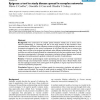1945 search results - page 6 / 389 » Pursuit-Evasion in Models of Complex Networks |
IJON
2000
13 years 6 months ago
2000
Cortical amplification is a mechanism for modifying the selectivity of neurons through recurrent interactions. Although conventionally used to enhance selectivity, cortical amplif...
BIBE
2007
IEEE
13 years 11 months ago
2007
IEEE
Multi-state molecules and multi-component complexes are commonly involved in cellular signaling. Accounting for molecules that have multiple potential states, such as a protein tha...
WETICE
2006
IEEE
14 years 1 months ago
2006
IEEE
In order to capture the increased complexity of products and production processes as well as market requirements, collaboration models representing organisational networks enable ...
CAAN
2004
Springer
14 years 13 days ago
2004
Springer
It appeared recently that the classical random graph model used to represent real-world complex networks does not capture their main properties. Since then, various attempts have ...
SCFBM
2008
13 years 6 months ago
2008
Background: The construction of complex spatial simulation models such as those used in network epidemiology, is a daunting task due to the large amount of data involved in their ...

